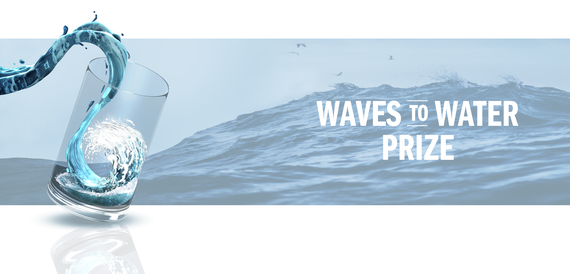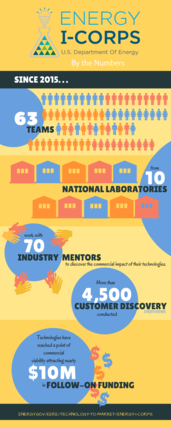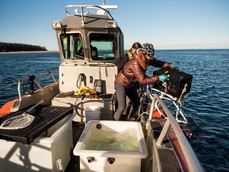 What’s Inside: This edition of the Water Wire shares upcoming deadlines, prize updates, upcoming events and webinars, newly released products and publications, STEM spotlight, a project spotlight from the 2019–2020 Accomplishments Report, and other hot topics.
Sign up for our brand new Marine Energy and Hydropower listservs to dive deeper into our technologies, activities, and successes!
Reach out to WaterPowerTechnologiesOffice@ee.doe.gov with any inquiries or suggestions.
Estimated read time: 7.5 minutes
Upcoming Deadlines
Prize Updates
WPTO Announces Waves to Water Prize ADAPT Stage Winners
 On February 9, WPTO announced 10 winners for the ADAPT Stage of the Waves to Water Prize. In this stage, competitors designed flexible systems to meet site conditions at Jennette’s Pier in the Outer Banks of North Carolina. Offering $3.3 million in prizes, this five-stage, 3-year prize is focused on advancing transformational technology to meet the global need for secure and affordable drinking water. The 10 winners will transition to the CREATE Stage to focus on building a functional prototype or proof-of-concept of their system and develop a plan to build a deliver their technology for the final DRINK Stage, where their systems will be tested in April 2022 at Jennette’s Pier in partnership with the Coastal Studies Institute. Additionally, WPTO announced two new sponsors of the prize—the International Desalination Association and Janicki Industries—to support prize competitors moving forward as they develop their solutions.
Upcoming Events and Webinars
Join Us for the Semiannual WPTO Stakeholder Webinar
Interested in learning more about WPTO’s activities, partnerships, and programs? Curious about what’s on the horizon for water power R&D in 2021? Join us March 1, from 3:30–5 p.m. ET, for our semiannual stakeholder webinar, where we’ll delve into current topics of interest. This webinar is one of WPTO’s many efforts to enhance transparency and engagement with the diverse groups of water power science and research stakeholders. Email questions ahead of the webinar and register today!

Products and Publications
INL’s Energy I-Corps Video: Enhancing Revenue of Existing Hydropower Assets
Researchers from Idaho National Laboratory (INL) have released a capstone video, “Hydro + Storage: Enhancing revenue of existing hydropower assets,” as part of a graduation ceremony from DOE’s Energy I-Corps, a program designed to pair scientists and engineers with industry mentors for an intensive two-month training focused on business development and commercialization. Through I-Corps, the INL team conducted customer discovery interviews, explored potential pathways to competitive markets, and defined the value proposition of their technology. The subject of INL’s I-Corps efforts was the Integrated project, a multi-lab R&D effort designed to integrate energy storage devices as “virtual reservoirs” that can increase the revenue of existing run-of-river hydropower plants traditionally limited in their energy storage capabilities. Check out the full video for more information on the INL team’s results.
PNNL Reports on Marine Energy in Integrated Resource Plans
Last month, Pacific Northwest National Laboratory (PNNL) released a report entitled, Review of Marine Renewable Energy in Integrated Resource Plans. As part of a literature review of reference material for grid applications of marine energy capture technologies, PNNL surveyed U.S. electric utilities’ integrated resource plans for the mention or treatment of marine energy technologies, principally those harnessing waves, tides, and ocean currents, as well as offshore wind. This review offers a window into utility decision-making and data utilization about these generating technologies. The report also offers perspectives on the relationship between traditional and emerging resource planning paradigms and metrics.
|
Report: Power System Modeling for Hydropower
A new report by PNNL and NREL researchers identifies a path forward for hydropower research and strategies to resolve gaps in the characterization of hydropower resources within electric power system models. The report, based on input gathered during a 2019 workshop, intends to support the hydropower industry by evaluating operations and grid resilience and clarifying the value of hydropower services to water managers. Learn more by visiting the PNNL website.
OES: An International Evaluation and Guidance Framework for Ocean Energy Technology
To take full advantage of the ocean’s immense energy potential, nations around the world are focused on developing new technologies, but they lack a comprehensive, internationally-recognized method for evaluating these technologies. Task 12 of the Ocean Energy Systems (OES), an International Energy Agency Technology Collaboration Programme, aims to develop an internationally agreed process for maturation and evaluation of marine energy technology. The OES produced a Task 12 report, which presents a framework for technology evaluation and guidance on engineering activity, ensuring availability of consistent information for decision-makers. The scope of this publication incorporates technology associated with utility-scale electricity generation from ocean waves and tidal streams. Future Task 12 activity will expand to incorporate other forms of marine energy. To learn more, check out the report on the OES website.
STEM Spotlight
Triton Stories: Creating Ears Under Water
Did you know that because many marine animals are responsive to noise in their environment, they can be greatly impacted by disruptions or changes to their accustomed soundscape? At PNNL, a marine scientist and principal investigator for the Triton Initiative, Joe Haxel, leads the underwater noise research for the Triton Field Trials (TFiT).
His work in this role entails planning field tests, identifying cost-efficient technologies, refining methods, and applying the international technical specification to their deployments. Haxel and his team use commercial off-the-shelf technologies like hydrophones to gather acoustics data at sites of interest. Read more about the TFiT work and mission.
2019–2020 Accomplishments Report: Project Spotlight
Capturing Wave Energy’s Full Potential with the Resource Characterization Project
Success can take many forms. In this case, it is a number: 30. Developed as part of the multi-lab resource characterization project, a new methodology for capturing U.S. wave energy resources resulted in a 30% increase in the estimate of the U.S. wave energy resource potential. This refined wave resource assessment methodology enables an accounting of the effect of local winds blowing on the ocean surface within the U.S. Exclusive Economic Zone, as well as the waves that arrive at our coastlines from the open ocean. The Pacific Northwest National Laboratory, Sandia National Laboratories, and the National Renewable Energy Laboratory have released a high-spatial-resolution, publicly-accessible ocean surface wave hindcast dataset, improving our understanding of the nation’s wave energy resources and providing an important tool for advancing marine renewable energy technologies. Explore the dataset to learn more, and check out more successes in the WPTO 2019–2020 Accomplishments Report.
In Case You Missed It
PacWave Releases RFI To Solicit Feedback from Wave Energy Technology Developers and Stakeholders
It’s not too late to submit your feedback to the PacWave request for information (RFI). This RFI solicits input from the wave energy converter R&D community, the developers of related blue economy technologies, and other stakeholders. The RFI specifically requests feedback to help the PacWave team understand how the facility can be used to most effectively meet the testing needs of the wave energy community and to ensure testing opportunities are aligned with industry and stakeholder needs.
The Past, Present, and Future of PNNL’s Sequim Laboratory

The Marine and Coastal Research Laboratory (MCRL), previously known as the Marine Sciences Laboratory, at PNNL’s Sequim site, is expanding its coastal research. The site holds historical significance, where the archaeological record contains more than 13,000 years of recorded activities, closely intertwined with the marine environment. MCRL is focused on safely harnessing the power of the ocean and coasts, predicting and strengthening their resilience and security, and inspiring the next generation of researchers for the betterment of the planet and its people. Check out a recent PNNL article to learn more.
|
NOSB’s 2021 ‘Ask an Expert’ Webinar with DOE Labs and Partners
On January 19, the National Ocean Sciences Bowl (NOSB) allowed 2021 competing students to “Ask an Expert” all their questions in the marine energy space. Experts from WPTO, NREL, PNNL, Ocean Renewable Power Company, and the University of Alaska Fairbanks provided an update on current and future developments in marine and riverine energy technologies along U.S. coasts in or near polar waters. Watch the full webinar to learn more and view past webinars on NOSB’s YouTube channel.
Sea Technology Magazine’s January Edition
This month, Sea Technology Magazine featured an article by WPTO Director Alejandro Moreno and Senior Advisor Jennifer Garson on marine energy for the blue economy. The article, “Taking an End User Approach to Tomorrow’s Energy Tech,” explores the seemingly limitless potential of the ocean. The article also discusses WPTO’s role in developing marine energy technologies, closely coupled with the needs of communities and companies that will ultimately use these solutions. Efforts such as these are helping realize the value of the ocean and its ability to sustainably meet the energy needs of the burgeoning blue economy.
|